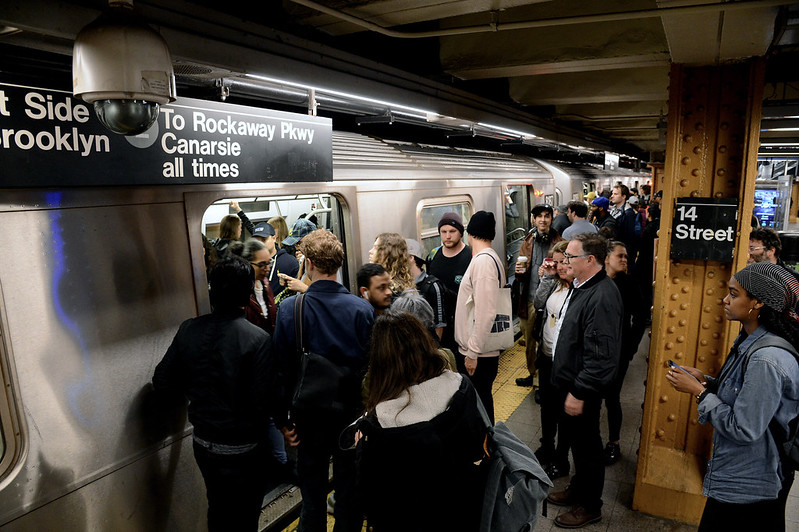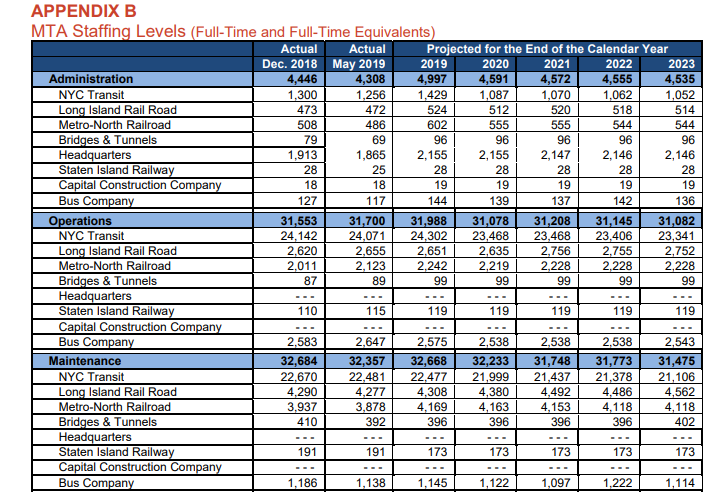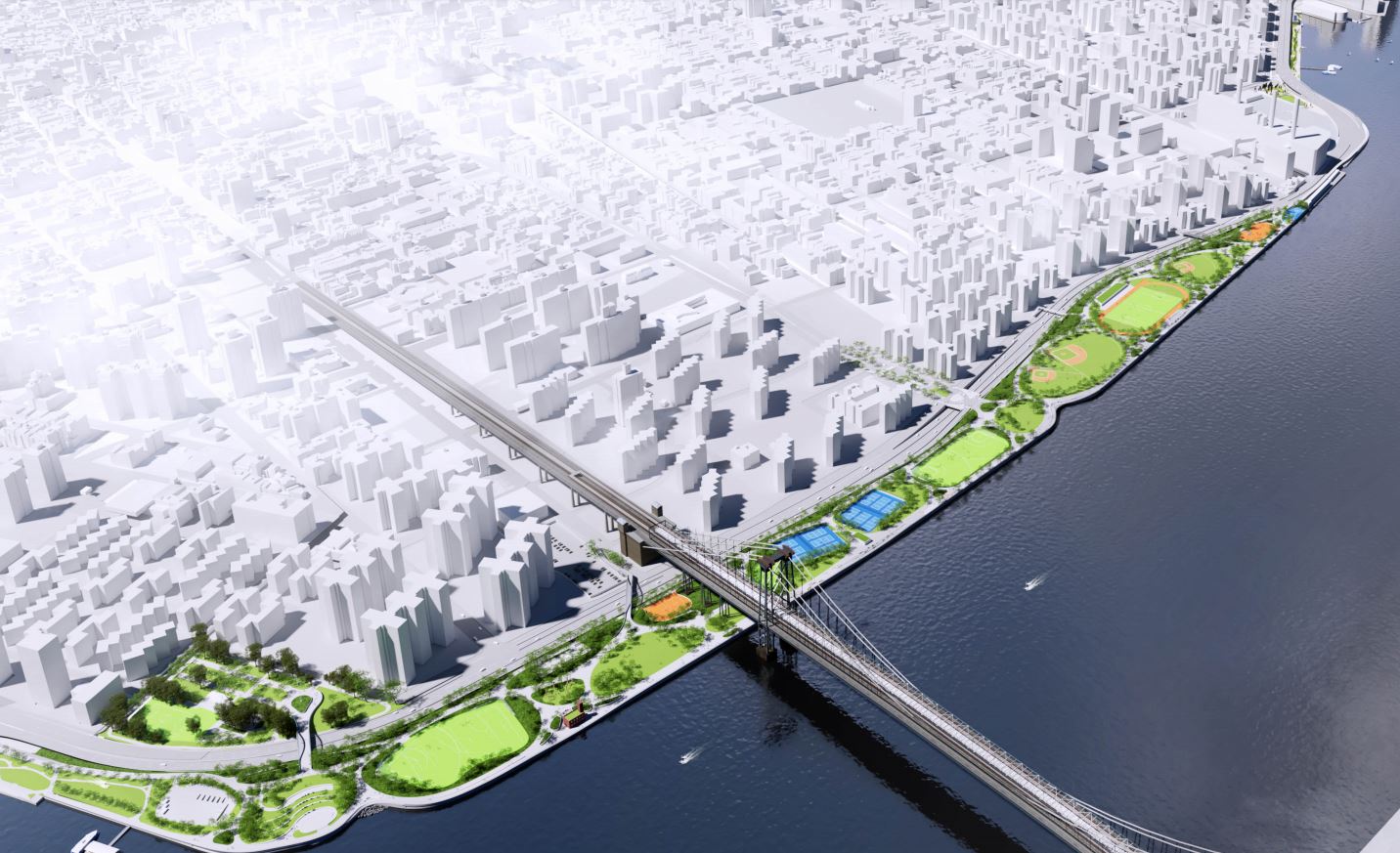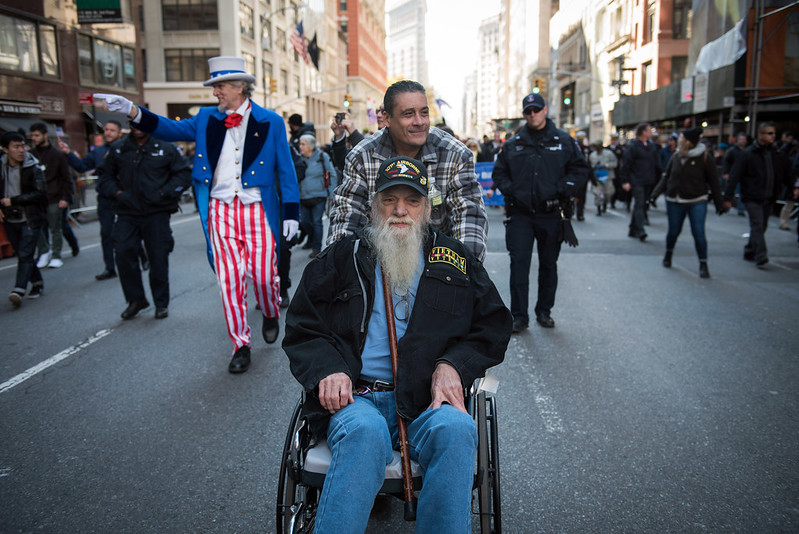MTA May Have Halted Subway Ridership Decline, But Gains Very Fragile

(photo: Marc A. Hermann/MTA New York City Transit)
The New York City Transit and Bus Committee of the MTA Board reported at its October 2019 meeting that weekday ridership of the subway grew 1.4% in September of this year compared to last, and that there have been four straight months of subway ridership gains. The MTA put out a gushing October press release that subway weekday ridership this September was up 4.5% over September 2018, and bus weekday ridership was up 1.5% over September 2018.* Revenue was up over forecasts as well.
The MTA attributed the improvement to the Subway Action Plan and a restoration of on-time performance to 82.7% in September 2019, compared to 69% a year prior. The Subway Action Plan invested heavily in operations and maintenance improvements like eliminating track fires, deploying emergency personnel, fixing signals and track, more rapid repairs, as well as other measures like increasing speeds on subway lines where speed limits had been imposed starting in the 1990s.
This is obviously good news since subway ridership peaked in 2015, stayed flat in 2016, and declined in 2017 and 2018. State Comptroller Tom DiNapoli’s office has estimated that the ridership decline is costing the MTA $250 million a year. Any revenue gains are welcome, especially to the extent that they reflect improved public confidence in the mass transit system.
Despite the recent improvement, MTA documents still acknowledged that average weekday ridership for all of New York City Transit (subways and buses) was still down 0.6% from the prior year-over-year (September 2017-September 2018, verus. September 2018-September 2019), so a recovery is actually just beginning.
But the subway ridership gain is especially fragile because the MTA is projecting deficits of $1.9 billion by 2023 before fare and toll hikes and its budget reduction and “transformation” plans are implemented, after which there is still a projected deficit in 2023 of $433 million.
Unfortunately these plans to address deficits include staff reductions of 3,000-4,000 jobs, including reductions of 2,300 jobs in operations and maintenance personnel at New York City Transit from the 2019 staffing peak related to the Subway Action Plan.
Below is a table taken from the Comptroller’s report using the MTA’s projections.

It is uncertain how the MTA will preserve the on-time performance and ridership gains while cutting 2,300 operations and maintenance personnel.
Projecting the revenue gains from the September ridership increases would yield another $100 million for the MTA in 2020, perhaps higher by 2023. This is just back-of-the-envelope math, but the potential of retaining, regaining, or gaining more riders is there and that’s why personnel cuts of such magnitude are problematic.
The MTA is also hiring 500 more police officers, at an estimated cost of $50 million a year, for various public safety and fare evasion deterrence purposes, without booking any more revenue from the fare evasion deterrence. The agency says fare evasion now costs it $260 million a year. The MTA has yet to provide any metrics or a clear plan for how the extra cops will be worth the cost, but I would still give the extra cops the benefit of the doubt at a minimum at deterring crime. The MTA owes the public a better explanation for what benefits the new officers will offer.
Even a revenue gain of $100-$200 million a year from improved ridership won’t be a miracle for the MTA when it faces deficits of $1.9 billion a year, with $433 million still left after implementing current plans by 2023.
When the Legislature provided funding for the Subway Action Plan and the new congestion pricing and various tax hikes for the 2020-2024 MTA Capital Plan, it left the MTA little extra room to address its deficits. The Action Plan funded staff-ups for service improvement, most of which need to be sustained (and the money spent). Congestion pricing and the other new revenue is prohibited from being used for operating deficits. Essentially Governor Cuomo and the Legislature left the MTA stranded and needing to find a way internally to cope with its deficits, which involve a mismatch between revenue, including its farebox and dedicated taxes, growing at 1% a year, and its costs, growing at 3% a year, mostly debt service costs and health insurance.
With the Legislature up for election next year, tax increases are unlikely. But there are still large sums of money unspent in the Dedicated Infrastructure Reserves set up from the Financial Settlements over the past years. Just giving the MTA $150 million from the reserves next year to preserve operations and maintenance services (and the ridership gains), to New York City Transit and commuter rail, would give the MTA more time to continue the gains of the past year and find efficiencies without harming service.
In 2021, the Legislature could look at some modest new sources of revenue, like the for-hire-vehicle surcharges, or substituting some sources of revenue for the MTA with others that more closely correlate with economic growth.
***
Jim Brennan was a member of the New York State Assembly for 32 years, where he chaired four committees. On Twitter @JimBrennanNY.
***
Have an op-ed idea or submission for Gotham Gazette? Email This email address is being protected from spambots. You need JavaScript enabled to view it.
*The MTA notes its ridership numbers may be subject to future revision.
City Council Must Act Now to Protect the Lower East Side

(rendering: City of New York)
It has been seven years since Superstorm Sandy made landfall on our city, causing billions of dollars in damage and ravaging some of our city’s most critical infrastructure, including our parks. It took years for the famous boardwalks in Coney Island and the Rockaways to re-open. Trees across our coastlines died and continue to be at risk from exposure to salt water. And many of our coastal parks are no less protected from the next big storm today than they were in 2012.
As a steward and advocate for our city’s parks, I know that we can’t pass up an opportunity to protect our coast and our parks in Lower Manhattan with the East Side Coastal Resiliency project (ESCR). This project, built the right way, can protect East River Park and the neighborhoods surrounding it for generations.
When the city initially proposed a revised ESCR design, my organization, New Yorkers for Parks, voiced our frustration. East River Park is one of the few large, open green spaces with baseball and soccer fields in Lower Manhattan, and so many low- and middle-income New Yorkers rely on it as a home away from home. We made it clear that we would only support a plan that used phased construction, preventing the long-term displacement of park-users from the area.
Today, thanks to the advocacy of City Council Members Carlina Rivera, Keith Powers, and Margaret Chin, as well as Manhattan Borough President Gale Brewer, the city has committed to a construction plan that is phased, ensuring nearly 50 percent of the park remains open at all times. In addition, the city has provided a plan to ensure local youth sports teams can continue to play in the park and at surrounding sports fields and parks, many of which are receiving long-overdue repairs and upgrades.
And a new tree planting campaign has already been launched in the neighborhood, with over 1,000 trees expected to be planted in addition to the hundreds of new trees replacing the dead or aging trees in East River Park.
But in order to make this plan truly work for the most impacted communities, we must continue to call on city agencies for greater involvement and community coordination. Part of that effort must include new major maintenance investments in this park and others so that our parks do not fall into disrepair. It is not enough to simply rebuild a park: it is our duty to maintain it, especially when it is our first line of defense for climate change.
It’s expected that ESCR will provide coastal protections within three years. But if the City Council fails to approve this land action now, the project would likely never return, and we will lose the $335 million in federal funds that must be spent by 2022. This funding is a one-time opportunity. Losing it would be yet another tragedy.
Lower Manhattan residents deserve a park that will not only protect their homes but will protect their future. The city has never embarked upon a resiliency plan of this scale - and while the project may not be perfect, we have to start somewhere.
During Superstorm Sandy, water infiltrated all five boroughs; storm surges don’t discriminate. Other stretches of our waterfront will require similar investments in the not-too-distant future.
The time to plan is now. The time to act is now. Let’s make this happen.
***
Lynn Kelly is Executive Director of New Yorkers for Parks. On Twitter @lynnbod & @NY4P.
***
Have an op-ed idea or submission for Gotham Gazette? Email This email address is being protected from spambots. You need JavaScript enabled to view it.
New York to DC: Pay Your Bill for Your Veterans

(photo: Ed Reed/Mayoral Photo Office)
Each year around Veterans Day there’s a predictable pattern as politicos of all stripes march in parades and roll out proposals to thank and support our military veterans and their families. Little may come from all this activity, at least until Memorial Day, when, once again, there’s renewed focus on veterans and their survivors. It doesn’t have to be this way and it shouldn’t be this way, particularly in New York.
A report released earlier this year from the New York City Bar Association suggests New York’s veterans, when compared with their national counterparts, are not getting their fair share from Washington, D.C. Specifically, veterans in New York are not getting their fair share of veterans benefits from the U.S. Department of Veterans Affairs, commonly known as “the VA.”
The City Bar’s report points out how, nationally, approximately a quarter of all veterans receive benefits from the VA, ranging from a few hundred dollars a month to thousands of dollars a month. By contrast, less than 17 percent of New York’s veterans across the state receive these benefits. In New York City, fewer than 16 percent of veterans receive these benefits.
At first blush a difference of seven or eight percent below the national average might seem statistically insignificant, however nothing could be further from the truth as there’s real money at stake. Over 100,000 low-income and disabled veterans in New York receive over $2.5 billion every year in financial support from the VA. These veterans either are unable to work or have some type of health condition that impacts their ability to hold “substantially gainful employment” as that phrase is understood as a matter of law.
These are our veterans who are most in need. Yet the report from the New York City Bar Association suggests there are tens of thousands of additional New Yorkers who should be receiving these benefits.
Practically, if New York’s leaders don’t insist Washington pay its fair share for the veterans it creates, the burden for the care of these veterans falls upon New York City and New York State taxpayers, who are already paying for VA benefits in their capacity as federal taxpayers. State and local tax revenue that should be going toward education, roads, and public goods are instead being appropriated to take care of low-income and disabled veterans who are, legally, the responsibility of the federal government.
New York leaders should be relentless in demanding every low-income disabled veteran who is entitled to benefits from the VA receives those benefits, even if obtaining them requires the assistance of an attorney. The New York City Bar Association’s report provides a roadmap and outlines steps to tackle the problem that should be revenue neutral, if not revenue positive, for New York and its taxpayers.
These steps include: providing funding for attorney representation on veterans benefits issues outside the scope of traditional general civil legal services; ensuring there are attorneys in adequate number to address the staggering demand; and making sure attorneys doing the work are evaluated on their cost-savings to New York taxpayers.
Each year around Veterans Day there is a great deal of talk about the importance and the value we place on the service of our veterans. New York leaders should back up that talk with real steps to assist not only our low-income, disabled veterans but also New York taxpayers by assigning the fiscal responsibility for low-income and disabled veterans to whom that responsibility rests: the U.S. Department of Veterans Affairs.
***
Kent Eiler is an attorney, the project director of the City Bar Justice Center’s Veterans Assistance Project, and a Major in the United States Air Force Reserve. The views expressed in this article are solely those of the author in his personal capacity and do not reflect the official policy or position of any military service, the Department of Defense, or the U.S. Government. On Twitter @KentEiler.
***
Have an op-ed idea or submission for Gotham Gazette? Email This email address is being protected from spambots. You need JavaScript enabled to view it.




